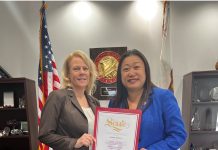Southern California Edison’s president, Pedro Pizarro, agreed to meet Laguna Beach Mayor Bob Whalen later this month to discuss fast-tracking and cost-sharing a citywide project to underground utility lines.

Reacting to the July 3 brush fire ignited by sparks from Edison transmission lines, Whalen last month reinvigorated a two-year-old initiative to bury Laguna’s utility lines, demanding a high-level meeting with Edison officials and describing the utility’s aboveground lines as a safety risk.
Seeking a partnership may be the best approach to gaining cooperation from Edison since regulations do not mandate burying utility lines and battling the utility over similar circumstances proved a six-year undertaking involving a $4 million lawsuit by another city.
Anaheim’s plan to require Pacific Bell Telephone Company to underground wires and bear the cost under a Public Utilities Commission code ultimately backfired. Pacific Bell agreed to perform the work, but refuted the requirement to pay. Anaheim paid for the project and sued to recover its costs, but lost. Ultimately, the California Court of Appeal ruled in 2004 that only the PUC had jurisdiction to hear the city’s complaint.
If the court required Pacific Bell to solely foot the bill for the undergrounding, it would potentially “interfere with the equitable determination of the order in which communities throughout the state should have their overhead facilities moved underground, a matter of statewide concern over which the PUC has jurisdiction,” the court opinion states.
Currently, the PUC promotes undergrounding by requiring that utilities set aside tariffs for undergrounding projects in high traffic roadways or areas of public recreation and scenic interest. But it also limits the amount of money available from the ratepayer funds for such undergrounding, resulting in waiting lists for such projects.
Even so, in 2013 the PUC ordered Edison to underground cables rather than erect massive transmission towers planned for a 3.5-mile stretch in Chino Hills, citing the public interest. Resident opposition to towers began in 2007. The recent vote reversed a 2009 decision allowing aboveground towers. At the time, PUC President Michael R. Peevey called the decision “the dawn of a new era in transmission line planning” that balances their impact on community values with the state’s energy goals. “I know undergrounding costs more, but I believe in this instance the costs are manageable and relatively minor considering the overall well-being of the populace in doing so,” he said.
Laguna Beach’s effort to underground its utility lines has yet to yield a comprehensive plan even though a task force is poised to present the City Council with recommendations for Laguna Canyon Road improvements that all hinge on the removal of the utility poles flanking it.
The prohibitive estimated $150 million expense to underground the city’s remaining poles, and the need for Edison’s cooperation in expediting the planning and execution of such a project have served as effective roadblocks to easy solutions.
A project to underground lines from 34 poles on Laguna Canyon Road begun five years ago is only now ready for execution, and has been reduced to 16 poles because of added cost and logistical complications of burying the higher-voltage transmission cables.
Whalen now hopes to capitalize on Edison’s responsibility to address safety concerns highlighted by last month’s fire. “We can no longer ignore the risks associated with overhead wires in our unique environment and topography where most of the city has been designated by the State of California as a very high risk fire hazard zone and the drought has raised fire risk to an unprecedented level,” he wrote to Pizarro. He called on him to partner with the city to bury the remaining wires at a fast pace, conceding that the solution “may include an investment from the city.”
Whalen said conditions “demand a margin of safety that cannot be provided by overhead electrical utilities.”
Council member Rob Zur Schmiede, the city manager, the fire chief, the director of public works, and the city project director will join Whalen at a meeting with the electric company’s chief executive on Aug. 21 at Edison’s headquarters in Rosemead.





[…] Edison and San Diego Gas and Electric officials and found they were not remotely interested in footing the cost of citywide undergrounding, the council members said. Acquiring the utilities would most […]